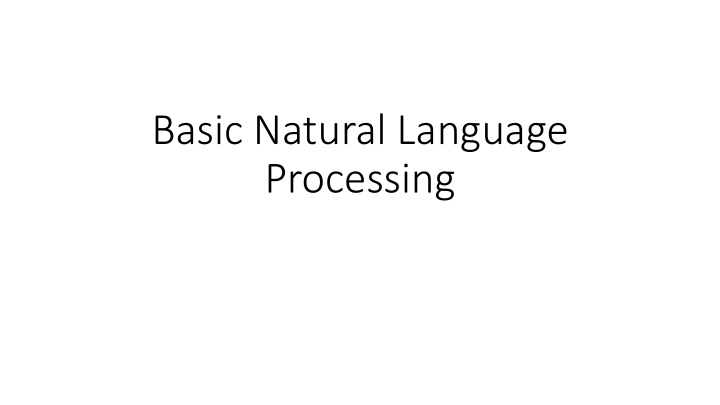



Basic Natural Language Processing
Why NLP? • Understanding Intent • Search Engines • Question Answering • Azure QnA, Bots, Watson • Digital Assistants • Cortana, Siri, Alexa • Translation Systems • Azure Language Translation, Google Translate • News Digest • Flipboard, Facebook, Twitter • Other uses • Pollect, Crime mapping, Earthquake prediction
Understanding human language is hard NLP requires inputs from : Human • Linguistics (U)nderstanding • Computer Science • Mathematics Computer • Statistics • Machine Learning • Psychology (G)eneration • Databases Human
THE KEY: Changing uncertainty to certainty I am changing this sentence to numbers 1 2 3 4 5 6 7 “ Vectorizing ” You are changing too many sentences! 8 3 ? ? ? 9 Remember: There is no ambiguity with numbers!
Challenges in NLP: Syntax vs. Semantics • Syntax: • Lamb a Mary had little • Semantics: • Merry hat hey lid tell lam • Colorless orange liquid • Address, number, resent
Challenges in NLP: Ambiguity pt 1 • CC Attachment • I like swimming in warm lakes and rivers • Ellipsis and Parallelism • I gave the Steven a shovel and Joseph a ruler • Metonymy • Sydney is essential to this class • Phonetic • My toes are getting number • Pp Attachment • You ate spaghetti with meatballs / pleasure / a fork / Jillian /
Challenges in NLP: Ambiguity pt 2 • Referential • Sharon complimented Lisl. She had been kind all day. • Reflexive • Brandon brought himself an apple • Sense • Julia took the math quiz • Subjectivity • Karen believes that the Economy will stay strong • Syntactic • Call a dentist for Wayne
Challenges in NLP: Others • Parsing N-grams: • United States of America • Hot dog • Typos • John Hopkins vs Johns Hopkins • Non-standard language • (208)929-6136 vs 208-929-6136 • Cause = because • SARCASM • I love rotting apples
Edit Distance: How we Spellcheck S T R E N G T H 0 1 2 3 4 5 6 7 8 • Can reference box above, left, or T 1 1 1 2 3 4 5 5 6 diagonal up-left • If letter matches, +0 R 2 2 2 1 2 3 4 5 6 • If letter doesn’t match, +1 E 3 3 3 2 1 2 3 4 5 • Score is the box at the bottom-right N 4 4 4 3 2 1 2 3 4 D 5 5 5 4 3 2 2 3 4
Semantic Relationships • Measuring how words are related to each other. • Birdcage will be more similar to Dog Kennel than it will be to Bird • Many different systems to draw out semantic relationships, but ‘Wordnet’ is one of the most commonly used • Similarity metric: • Sim(V,W) = - ln(pathlength(V,W)) • Sim(Run, Miracle) would be = -ln(7)
Preprocessing: Stopwords and punctuation Why we want to get rid of them? • “And”, “If”, “But”, “.”, “,” • Will almost ALWAYS be your most significant words • Tells you nothing about what’s going on Don’t get rid of them if you are focused on Natural Language Generation!
Preprocessing: Porter’s Algorithm Measure: • A ‘ measure’ of a word is an indication of how many syllables are in it. • Consonants = ‘C’, Vowels = ‘V’ • Every sequence of ‘VC’ is counted as +1 • Intellectual = (VC)C(VC)C(VC)CV(VC) = 4 Stemming: • Strip a word down to its barest form • Ex: ‘Alleviation’ – ‘ ation ’ + ‘ate’ = ‘Alleviate’ Transformational Rule
Stemming: Sample Rules • If m>0: • Lies -> li • Abilities = Abiliti • Ational -> ate • National = National • Recreational = recreate • Sses -> ss • Sunglasses = sunglass • Biliti -> ble • Abiliti = able
Stemming: Example • Original Word: “Computational” • Computational – ‘ ational ’ + ‘ate’ = Computate • Computate – ‘ate’ = Comput • Final Word: “ Comput ” • Original Word: “Computer” • Computer – ‘ er ’ = Comput • Final Word: “ Comput ”
Sentence Boundary Recognition Problems with things like Dr., A.M., U.S.A. Use a decision tree to estimate the boundary Features: • Punctuation • Formatting • Fonts • Spaces • Capitalization • Known Abbreviations
N-Gram Modeling Words that have a separate meaning when combined with other words The best way to highlight the importance of context Examples: • Unigram: Apple • Bigram: Hot Dog • Trigram: George Bush Sr. I’ll meet you in Times {?????}
Preprocessing Checklist Remove Remove Convert Tokenize Tokenize Stopwords Stemming / Identify N- Extraneous sentences to Sentences Words & Lemmatizing Grams Text lower case Punctuation
Words to Numbers • Corpus creation • Create a library of all words in original dataset • Vectorizing • Changing words to numbers • Often a raw count • TFIDF • Term Frequency / Inverse Document Frequency • Example: • “This” mentioned 3 times in a given review, but the review has 27 words in it • Tfidf = 3 / 27 = 1/9
Bayes Theorem P(A) P(B|A) P(A|B) = P(B)
Predicting the next { … } Example from Charles Dickens: • P(“Darnay looked at Dr. Manette ”) • Use maximum likelihood estimates for the n-gram probabilities • Unigram: P(w) = c(w)/V • Bigram: P(w1 | w2) = c(w1,w2)/c(w2) • Values - P(“Darnay”) = 533 / 598633 = .00089 - P(“looked”|”Darnay”) = 3 / 676 = .0044 - P(“ at|looked ”) = 77 / 312 = .247 - P(“Dr. Manette ” | “at”) = 2 / 4512 = .000443 • Bigram probability - P(“Darnay looked at Dr. Manette ”) = 4.28 * e^ -10 • P(“at Dr. Manette Darnay looked”) = 0
The Bag of Words Approach • P(Positive Review | Words Contained) • Look at the unordered words of a document to determine underlying characteristics • Coffee reviews with the word ‘bean’ tend to be far more positive • Common in sentiment and feature analysis
Recommend
More recommend